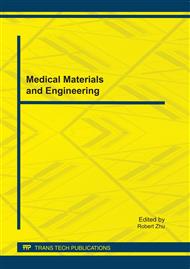[1]
D. Prakash, G. Upadhyay , B. N. Singh, H. B. Singh, Antioxidant and free radical scavenging activities of seeds and agri-wastes of some varieties of soybean (Glycine max), Food Chem.104 (2007) 783–790.
DOI: 10.1016/j.foodchem.2006.12.029
Google Scholar
[2]
P. Valentão, E. Fernandes, F. Carvalho, P. B. Andrade, R. M. Seabra, M. L. Bastos, Antioxidative properties of cardoon (Cynara cardunculus L.) infusion against superoxide radical, hydroxyl radical, and hypochlorous acid, J. Agric. Food Chem. 50 (2002) 4989-4993.
DOI: 10.1021/jf020225o
Google Scholar
[3]
H. A. Jung, J. C. Park, H. Y. Chung, J. Kim, J. S. Choi, Antioxidant flavonoids and chlorogenic acid from the leaves of Eriobotrya japonica, Arch. Pharmacal. Res. 22 (1999) 213-218.
DOI: 10.1007/bf02976549
Google Scholar
[4]
G. Cao, S. L. Booth, J. A. Sadowski,R. L. Prior, Increases in human plasma antioxidant capacity after consumption of controlled diets high in fruit and vegetables, Am. J. Clin. Nutr. 68 (1998) 1081-1087.
DOI: 10.1093/ajcn/68.5.1081
Google Scholar
[5]
P. S. Jain , S. B. Bari, S. J. Surana, Isolation of stigmasterol and γ-sitosterol from petroleum ether extract of woody stem of Abelmoschus manihot, Asian J. Biol. Sci. 2 (2009) 112-117.
DOI: 10.3923/ajbs.2009.112.117
Google Scholar
[6]
S. Z. Li , Compendium of Materia Medica, first ed., People's Medical Publishing House,Beijing, 1977.
Google Scholar
[7]
D.F. Birt, S. Hendrich, W. Q. Wang, Dietary agents in cancer prevention: flavonoids and isoflavonoids, Pharmacol. Ther. 90 (2001) 157– 177.
DOI: 10.1016/s0163-7258(01)00137-1
Google Scholar
[8]
L. Fan, Y. Guo, Z. W. Chen, C. G. Ma, Protective effects of pharmacological preconditioning of total flavone of Abelmoschus Manihot L. medic on myocardial reperfusion injury in rabbits, Chin. Pharmacol. Bull. 22 (2006) 106-109.
Google Scholar
[9]
R.X. Hao, S. Zhou, Y. Yang, J. Z. Xi, W. Y. Li, Q. J. Tang, C.G. Wang, Flavone content and bioactibity of aqueous-ethanolic extracts of Phellinus fruit bodies, Acta Edulis Fungi.15 (2008) 27-30.
Google Scholar
[10]
C. X. Li, Y. Jiao, R. Zhang, Z. J. Hou, H.G. An, Studies on the antioxidative activity of the water extract of C.tangutica (Maxim.) Korsh flower, Nat. Prod. Res. Dev. 20 (2008) 134-137, 192.
Google Scholar
[11]
H. Li, Q. J. Wang, Evaluation of free hydroxyl radical scavenging activities of some Chinese herbs by capillary zone electrophoresis with amperometric detection, Anal. Bioanal. Chem. 378 (2004) 1801-1805.
DOI: 10.1007/s00216-004-2509-1
Google Scholar
[12]
B. Yang, J. S. Wang, M. M. Zhao, Y. Liu, W. Wang, Y. M. Jiang, Identification of polysaccharides from pericarp tissues of litchi (Litchi chinensis Sonn.) fruit in relation to their antioxidant activities, Carbohydr. Res. 341 (2006) 634–638.
DOI: 10.1016/j.carres.2006.01.004
Google Scholar
[13]
M.Y. Shon, T. H. Kim, N. J. Sung, Antioxidants and free radical scavenging activity of Phellinus baumii (Phellinus of Hymenochaetaceae) extracts, Food Chem. 82 (2003) 593-597.
DOI: 10.1016/s0308-8146(03)00015-3
Google Scholar
[14]
J. C. Lee, H. R. Kim, J. Kim, Y. S. Jang, Antioxidant property of an ethanol extract of the stem of Opuntia ficus-indica var. Saboten, J. Agri. Food Chem. 50 (2002) 6490-6496.
DOI: 10.1021/jf020388c
Google Scholar
[15]
B. H. Babu, B. S. Shylesh, Padikkala J. Antioxidant and hepatoprotective effect of Acanthus ilicifolius, Fitoter. 72 (2001) 272-277.
DOI: 10.1016/s0367-326x(00)00300-2
Google Scholar
[16]
M. Tanaka, C. W. Kuie, Y. Nagashima, T.Tauguchi, Application of antioxidative maillard reaction products from histidine and glucose to sardine products, Bull. Japan. Soc. Sci. Fish, 54 (1988) 1409-1414.
DOI: 10.2331/suisan.54.1409
Google Scholar
[17]
M. F. Gordon, The Mehanism of antioxidation action in vitro, in: B.J.F. Hudson (Ed.), Food antixoidants, Elsevier Applied Science, London/New York, 1990, pp.1-18.
Google Scholar


